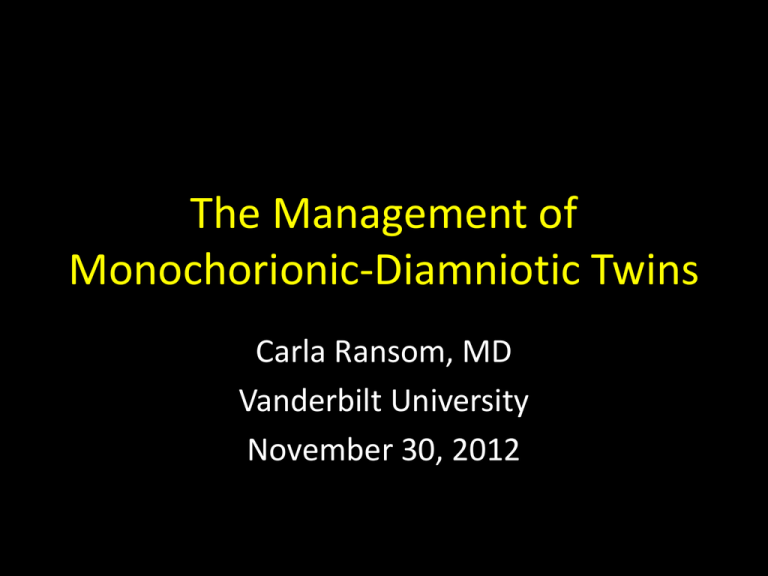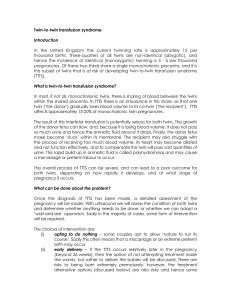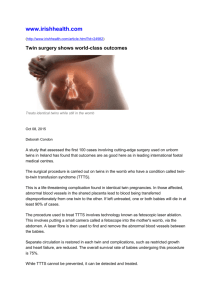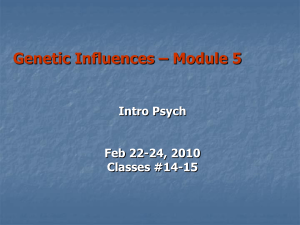The Management of Monochorionic-Diamniotic Twins
advertisement

The Management of Monochorionic-Diamniotic Twins Carla Ransom, MD Vanderbilt University November 30, 2012 The changing face of pregnancy Learning objectives • To understand the biology of twinning • To understand the complications associated with monochorionic gestation • To recognize the development of twin-twin transfusion syndrome (TTTS) • To understand the therapeutic options for TTTS • To understand the antenatal management of monochorionic gestation Session 1 – – – – Diagnosis of twin gestation Maternal & fetal morbidity Prevention of PTB Special situations: TTTS, death of one twin Session 2 – Prenatal diagnosis in twins – Antenatal testing – Delivery timing Disclosures • None U.S. Twin Births 160000 140000 120000 100000 80000 60000 40000 20000 0 1980 1985 1990 1995 Natl Vital Stat Rep. 2011 Nov 3;60(1):1-70. 2000 2003 2009 With advancing age, FSH/LH rise, as does DZ twinning With advancing age, FSH/LH rise, as does DZ twinning Lotze, R. Twins. Introduction to the twin research. F. Rau, Oehirngen. 1937. Zwillinge: Einfiihrungin die Zwillingsforschun Maternal Age Association with Multiples • At <20 yo multiple births represents 16 per 1000 live births • At ≥ 40yo- 70 per 1000 live births Ratio per 1,000 live births 80 70.3 60 45.9 40 20 0 27.7 16.1 <20 20-29 30-39 ≥40 Effect of Multiple Births • 3% of all live births • 17% preterm births (<37 wks) • 23% very preterm births (<32 wks) • 24% of low birthweight (<2500g) • 26% very low birthweight (<1500g) Nat Vital Stat Rep, Vol. 56, No. 6, December 5, 2007 Financial cost Singleton: $9,845 Twins: $37,947 ($18,974 per baby) Triplets: $109,765 for triplets ($36,588 per baby) N Engl J Med. 1994 Jul 28;331(4):244-9 Importance of Ultrasound in Multiples – Changes management of the pregnancy – – – – Prognosis Counseling Selective reduction options Appropriate follow up schedule – Having an accurate description of the number of: – Amnions – Chorions – Fetuses Accuracy of Referral Diagnosis • Incidence of wrong diagnosis of multiples at time of referral – 46% of twins unassigned – 66% of triplets unassigned – 44% of 289 referrals to USCD had accurate assignment of amnionicity and chorionicity • Wrong assumptions (with IVF or other) * Wan et al. Prenatal Diagnosis 2011:31:125-130. The biology of twinning Zygosity Amnionicity & chorionicity Placentation Zygosity Chorionicity Zygosity = Genetic Makeup Dizygotic – ovulation & fertilization of 2 oocytes – 69% of all twin births – Always results in diamniotic, dichorionic placentation – Usually 2 separate placentas Monozygotic - ovulation and fertilization of a single oocyte, with subsequent division of the zygote – 31% of all twin births – Timing of zygote division determines placentation although factors responsible for timing of egg division are not known Risk factors for occurrence Dizygotic Monozygotic • Ethnicity • Advanced maternal age • ART: multiple follicle development – 1:1000 Japan – 8:1000 Europe – 50:1000 Nigeria • • • • Maternal age Race Parity ART: multiple follicle development, >1 embryo Monochorionic/Monoamniotic Dichorionic/Diamniotic (fused) Monochorionic/Diamniotic Dichorionic/Diamniotic Amnionicity & Chorionicity- ? zygosity Placentation: Di Di Placentation: Di Di with fused single placenta Placentation: Mono Di Zygosity: - DZ - MZ with division within 3 days post fertilization Zygosity: -DZ with fused placenta -MZ with division within 3 days post fertilization Zygosity: - MZ: division 4-8 days post fertilization Cleavage timing: monozygotic Creasy & Resnick, 6th ed, p 57 Significance of Amnionicity & Chorionicity Monochorionicity more important than zygosity • 10 to 15 % of mono/di twins will develop twintwin transfusion syndrome • MC twins are at increased risk of neurologic morbidity, discordant birth weight, and co-twin in utero death • Selective reduction of one twin: – only an option for dichorionic/diamniotic – selective termination can result in death of co-twin SONOGRAPHIC SIGNS OF CHORIONICITY- DICHORIONIC PLACENTATION Separate placentas Callen, 2008 Twin peak/lambda sign Egan JF, Ultrasound in Twins, AIUM lecture series, 2012 Thick dividing membrane Egan JF, Ultrasound in Twins, AIUM lecture series, 2012 Gender discordance SONOGRAPHIC SIGNS OF CHORIONICITY- MONOCHORIONIC PLACENTATION T-sign Egan JF, Ultrasound in Twins, AIUM lecture series, 2012 Thin wispy membrane Egan JF, Ultrasound in Twins, AIUM lecture series, 2012 Di/Di vs Di/Mo 1st trimester membranes Di-Mo Twins - 13 weeks 3-D Imaging of Di/Mo and Di/Di Twins Di/Di vs Di/Mo 22 wks MVP with Membrane Di/Mo Di/Mo 2nd Trimester, Thin Membrane Pitfalls of Membranes + Not appreciating the draping or cocooning of membranes. + Fetal movement (changing position) + Wispy vs. thick membranes, especially with advancing gestation. + Synechiae + Mistaking umbilical cord for a membrane + Vessels in the membranes Draping Membranes Draping Membranes Around Extremities Helpful Hints About Membranes • Changing maternal position. • Looking at the “corners” of the fetus – Chin and chest – Shoulder – Behind knees – Between feet • Amniotic fluid density • Cord insertions near membranes – Marginal – Velamentous MATERNAL COMPLICATIONS Singleton (%) Twin (%) Relative Risk Preeclampsia 3.4 12.5 3.7 GDM 2.3 4 2.2 Threatened abortion 18.6 26.5 1.4 Thromboembolism Antepartum 0.1 0.5 3.3 Postpartum thromboembolism 0.2 0.6 2.6 Hyperemesis 1.7 5.2 3.0 Campbell DM, Templeton A: Maternal complications of twin pregnancy. Int J Gynecol Obstet Rauh-Hain, J matern Fetal Neonatal Med, 2009 . FETAL COMPLICATIONS Adverse Outcomes in Twins • • • • • • • Abnormal Fetal Growth Preterm Birth Fetal Demise Premature Rupture of Membranes Twin-twin transfusion syndrome Aneuploidy & malformations Malpresentation M&M Singleton Twins Mean birthweight 3298 g 2323 g Low birthweight (<2500g) 6.5 % 57.2% Very low birthweight (<1500g) 1.1% 10.2% Delivery < 32 weeks 1.6 % 12.1 % 38.7 weeks 35.2 weeks Risk of cerebral palsy --- 4 times higher Risk death by age 1 year --- 7 time higher Average gestational age ACOG practice bulletin #56 Martin JA, Hamilton BE, Sutton PD, et al: Births: Final Data for 2006. National Vital Statistics Reports; Vol 57, No 7. Hyattsville, MD, National Center for Health Statistics, 2009. Fetal Growth in Twins • Same as singletons during 1st & 2nd trimesters • Generally follow singleton ultrasound growth charts • Likely slower growth during 3rd trimester Fetal Growth Restriction (FGR) • Placental crowding • Anomalous cord insertion • 14 – 25% of twins < 10th percentile birth weight Discordant Fetal Growth • ~ 15% of twins will be discordant • Higher incidence of FGR • Increased risk of neonatal death with >15% discordance • Discordance ranging 15 – 40% predictive of adverse outcome Preterm Birth in Twins • 17% of all preterm births • 57% of all twins are born < 37 weeks • Not all spontaneous preterm births – Preeclampsia, diabetes, nonreassuring fetal status Prediction of Preterm Birth Cervical length measurement • CL of ≤ 25mm between 24-28 weeks –OR PTB prior to 32 weeks: 6.9 (95% CI 2-24.2) –Risk PTB 27% in women with CL of ≤ 25mm compared to 5% if CL ≥ 25mm Am J Obstet Gynecol, 1996; 175: 1047 Prediction of PTB prior to 32 weeks in twins by cervical length Cut off for CL Sensitivity % Specificity % PPV % NPV % Assessment at 21 to 24 weeks of gestation 20 42 85 22 94 25 54 86 27 95 30 46 89 19 97 Assessment at 25 to 28 weeks of gestation 20 56 76 16 95 25 63-100 70-84 13-18 96-100 Vayssiere, AJOG, 2002; 187:1596. Prediction of Preterm Birth • Cervical length measurement • Fetal fibronectin Fetal Fibronectin in Twins • N = 147 twin pregnancies • fFN at 2-week intervals between 24 - 30 weeks • 30% with a positive test at 28 weeks delivered < 32 weeks vs. 4% with a negative result • When fFN was performed at 30 wks, 38% with a positive test vs. 1% with a negative test delivered < 32 weeks • However, only 13 of the 147 women delivered before 32 weeks Goldenberg RL et al, AJOG1996 Oct;175(4 Pt 1):1047-53 fFN + cervical length • 155 twin pregnancies • fFN + CL q2-3 weeks from 22-32 weeks Variable N Mean GA at Risk for spontaneous pretermbirth, % delivery <28 wk <30 wk <32 wk <34 wk <35 wk <37 wk 36.1 ± 2.3 1.6 2.4 4.2 10.3 18.3 43.0 1 positive 24 34.8 ± 3.1 13.3 9.5 8.3 26.1 39.1 77.3 Both positive 32.5 ± 3.8 50 33.3 54.5 54.5 54.5 100 <.001 <.001 .001 <.001 <.001 .005 <.001 All negative P-value 120 11 Prevention of Preterm Birth • Bedrest • Home uterine activity monitoring • Cerclage • Progesterone supplementation • Tocolytics Bedrest • Cochrane review of 6 RCTs: – 600 women, 1400 babies – Routine hospitalized bedrest offers NO BENEFIT in multiples • Home bedrest? – No prospective trials in multiples Bedrest- what’s the downside? • • • • • Increased risk thromboembolism Decreased bone mineralization Economics Depression, mood disorders ? Worse outcomes – Risk of PTB <34 weeks increased in women on bedrest (OR 1.84, 95% CI 1.01-3.34) Sciscione AC. Maternal activity restriction and the prevention of preterm birth. Am J Obstet Gynecol 2010;202:232.e1-5. Crowther, Cochrane Database Syst Rev, 1 (2001 Home uterine activity monitors • Meta analysis of 6 trials • No difference in the rate of PTB (RR 1.01, 95% CI 0.79-1.30) • Decreased risk PTL with cervix >2cm (RR 0.44, 95% CI 0.25-0.78) • No difference in infant birthweight or NICU admission Take home point: no role for HUAM in twins Colton, AJOG, 1995. cerclage • Prophylactic in twins: doesn’t work • Twins + cervical shortening: no clear benefit • Meta analysis (2005): – Twins WITH cerclage had HIGHER rates of: • Delivery prior to 35 weeks (75 % vs 36%) • RR 2.15 (95% CI 1.15-4.01) Berghella, Obstet Gynecol, 2005 Progesterone Briery Twins N=30 PTB < 35 wk 17-OHP [20-30 until 34 wk] 2.24 [0.8-6.3] Rouse Twins N=661 Delivery or death < 35wk 17-OHP [16-20 until 34 wk] 1.1 [0.09-1.3] Norman Twins N=500 PTB or death <34 wk Vaginal progesterone gel 1.27 [0.91-1.78} Tocolytics Prophylactic tocolysis: – 5 RCTs with 344 twin pregnancies – RR of birth <37 weeks 0.85 (95% CI 0.65-1.10) – RR of birth <34 weeks = 0.47 (95% CI 0.15-1.50) – RR neonatal low birthweight = 1.19 (95% CI 0.771.85) – RR neonatal mortality = 0.80 (95% CI 0.35-1.82) Take home point: do not use prophylactic oral betamimetics in twins W. Yamasmit, Cochrane Database Syst Rev, 20 (2005) Tocolytics for PTL • No difference in: – Delivery within 7 days of treatment – Perinatal or neonatal death – Neonatal complications: RDS, NEC, Cerebral palsy • Increased side effects in women with twins – Risk pulmonary edema TWINS: SPECIAL SITUATIONS Management of the death of one fetus Fetal Demise Higher rate of stillbirth than singletons • Placental insufficiency • Anomalous cord insertion • Monochorionicity – placental vascular connections • Preeclampsia Management of the death of one fetus • • • 2-7% in spontaneous twin gestations 25% in multiple gestations from ART. Vanishing twin: death of one fetus 1st trimester – Dickey et al • – “Vanishing twin” in 36% of twins, 53% triplets, 65% quads. Landy et al • 21% vanishing twin Am J Obstet Gynecol 2002;186(1):77-83. Am J Obstet Gynecol 1986;155:14-19. Mortality in co-twin • Fetal death at >20 weeks – 2.6% twins – 4.3% triplets • Same-sex twin – Fetal death 20-24wk: 8% survival – Fetal death >37 weeks: 85% survival • Opposite sex twins – Fetal death 20-24wk: 12% survival – Fetal death >37 weeks: 98% survival Obstet Gynecol 2002; 99:698 Morbidity in co-twin • • • • DIC Thromboemboli Hypotension Ischemic damage leading to structural defects – – – – – Intestinal atresia Gastroschisis Limb amputation Aplasia cutis Porencephalic cyst, hydranencephaly, or microcephaly • Cerebral palsy Semin Diagn Pathol 1993; 10:222 Obstet Gynecol 1991; 78:517 Lancet 2000;355:1597 Twin-twin transfusion syndrome Twin to Twin Transfusion Syndrome - TTTS Twin to Twin Transfusion Syndrome - TTTS Fisk NM: The scientific basis of feto-fetal transfusion syndrome and its treatment. In Ward RH, Whittle M [eds]: Multiple Pregnancy, pp 235–250. London, RCOG Press, 1995) Twin to Twin Transfusion Syndrome - TTTS Nikkels P G J et al. J Clin Pathol 2008;61:1247-1253 Twin to Twin Transfusion Syndrome - TTTS Nikkels P G J et al. J Clin Pathol 2008;61:1247-1253 Twin to Twin Transfusion Syndrome - TTTS Courtesy of Dr. Kurt Benirschke Twin to Twin Transfusion Syndrome - TTTS Courtesy of Dr. Kurt Benirschke TTTS Staging Four published staging systems: Quintero Cincinnati * Cardiovascular profile scoring * Children’s Hospital of Philadelphia * *Fetal echocardiogram findings included Quintero Staging Gestational Age Donor DVP Recipient DVP <20 wks ≥ 8cm < 2cm ≥ 20 wks ≥ 10cm < 2cm Concurrently with: Stage I Bladder filling in donor Stage II Absent bladder filling in donor Stage III Abnormal Dopplers: • AEDF in donor • Reverse DV a-wave Stage IV Stage V Hydrops in one or both twins Death of one or both twins Cincinnati Staging Stage Donor DVP Recipient DVP Recipient Cardiomyopathy I < 2cm ≥ 8cm No II Bladder not visible Bladder visible No IIIA Mild * IIIB Moderate * IIIC Severe * IV Hydrops Hydrops V Death Death * Cardiac Variables Cardiomyopathy Mild Moderate Severe AV regurgitation Mild Moderate Severe RV/LV thickness >2 + Z-score >3 + Z-score >4 + Z-score MPI >2 + Z-score >3 + Z-score Severe biventricular dysfunction Cardiovascular Profile Score Findings Normal +2 points each 1 Point Deduction 2 Point Deduction Hydrops None Ascitis; pleural and pericardial effusion Skin edema Venous Doppler Normal DV atrial systolic reversal Umbilical venous pulsation Cardiothoracic ratio < 0.35 >0.35 and <0.5 > 0.5 Ventricular SF >0.28 and valve regurgitation SF < 0.28 or TR or semilunar valve regurgitation TR plus dysfunction or any mitral regurgitation Normal AEDF REDF Cardiac Function Arterial Doppler CHOP Staging Recipient 0 points 1 point 2 points Cardiac enlargement None Mild > Mild Systolic dysfunction None Mild > Mild Ventricular hypertrophy None Present Tricuspid regurgitation None Mild > Mild Mitral regurgitation None Mild > Mild Tricuspid valve inflow 2 peaks 1 peak Mitral valve inflow 2 peaks 1 peak Ductus Venousus All forward Decreased atrial contraction No pulsation Pulsations Outflow tracts PA > AO PA = AO Pulmonary Insufficiency Absent Present Normal Decreased diastole Ventricular Findings Valve Function Venous Doppler findings Umbilical vein Reversal Great Vessel findings Donor Twin Umbilical Artery PA < AO, RVOTO Ab Consensus Statement • The Quintero staging system should be retained until a superior system has been appropriately validated. • Cardiac indices and markers of systemic hemodynamic alterations may improve prediction of disease progression and/or perinatal outcomes…[but] should be assessed and validated individually and in combination within a clinical trial. Stamilio DM, Fraser WD, Moore TR. Twin-twin transfusion syndrome: an ethics-based and evidencebased argument for clinical research. Am J Obstet Gynecol. 2010; 203(1): 3-16 Stage I Poly-Oli Sequence Stage I Poly-Oli Sequence Stage II Poly-Oli Sequence with Absent Bladder Stage III Abnormal Doppler Studies Donor REDF Recipient Elevated MCA Reverse DV a-wave Stage III Cardiac Changes CT Ratio: 0.74 Stage IV Hydrops with Tricuspid Regurgitation What is the optimal interval for TTTS screening? Thorson 2011 • Restrospective look at 108 MC pregnancies – 42 with TTTS • Peak incidence occurred at 18 0/7- 18 6/7 weeks • 2/3 were diagnosed before 22 0/7 weeks • Screening interval >14 days associated with late Quintero stage at diagnosis (OR 9.45) Obstetrics & Gynecology. 117(1):131-135, January 2011. Early-stage or late-stage twin–twin transfusion syndrome by screening interval. Thorson. Screening Interval for Twin–Twin Transfusion Syndrome. Obstet Gynecol 2011. Cases of Twin-Twin Transfusion syndrome (n) Fig. 1. Incidence of twin-twin transfusion syndrome by gestational age Gestational age (weeks) 2 Obstetrics & Gynecology. 117(1):131-135, January 2011. Twin-Twin Transfusion Checks Di/Mo Twins, Every Two Weeks if Normal • Maximum vertical pockets* – Discordant fluid volumes. – 2 x 2 cm pockets with membrane in view • Bladder* • Evidence of hydrops, presence of effusions, ascites* • Doppler studies as indicated. • Cardiac size* • Cord diameter • Discordant placental size *“TTTS check” components TTTS Treatment Options • • • • • No treatment Serial amnioreduction Septostomy Selective Laser Photocoagulation (SLPC) Cord ligation In summary DIAGNOSIS- chorionicity matters! NUTRITION- follow weight gain goals REFERRAL TO MFM- for any high risk developments TTTS- occurs in 10-15% . Important to screen for this every 1-2 weeks throughout. Thank you!





